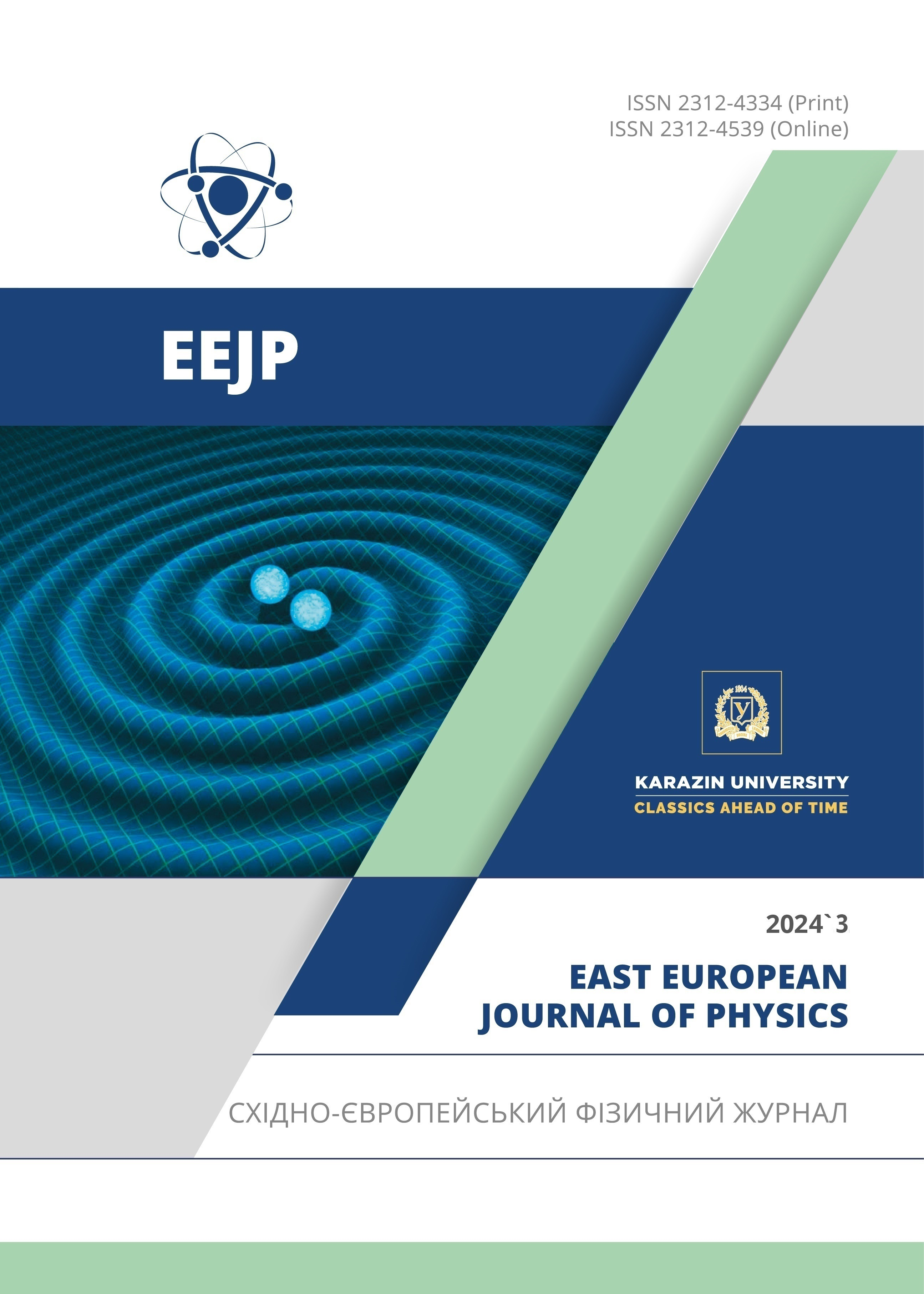Influence of Mixing Valence Band States to the Conduction Band States on Two-Quantum Linear-Circular Dicroism in Semiconductors
Abstract
A quantitative theory of two-photon linear-circular dichroism caused between the subbands of light and heavy holes of the valence band and conduction band is constructed, which takes into account the admixture of valence band states to the conduction band states and the temperature dependence of the band gap (Eg(T)) in semiconductors of tetrahedral symmetry in the multiband Kane model. It is shown that the type of oscillatory angular dependence or the amplitude values of the probabilities of two-photon optical transitions depend on the state of light polarization. This is due to the fact that, under the influence of linearly polarized light, alignment along the pulse occurs, and under the action of circularly polarized light, the moments of current carriers are oriented. It has been determined that the probability of two-photon optical transitions from the heavy hole subband to the conduction band of semiconductors at a fixed temperature increases with increasing frequency, passes through a maximum, and sharply decreases regardless of the degree of polarization of light, as well as the band gap.
Downloads
References
K.S. Novoselov, A.K. Geim, S.V. Morozov, D. Jiang, Y. Zhang, S.V. Dubonos, I.V. Grigorieva, and A.A. Firsov, “Electric field effect in atomically thin carbon films,” Science, 306(5696), 666–669 (2004). https://doi.org/10.1126/science.1102896
L.A. Chernozatonskii, and A.A. Artyukh, “Quasi-two-dimensional transition metal dichalcogenides: structure, synthesis, properties and applications,” UFN, 188(1), 3–30 (2018). https://doi.org/10.3367/UFNr.2017.02.038065 (in Russian)
W.S. Yun, S.W. Han, S.C. Hong, I.G. Kim, and J.D. Lee, “Thickness and strain effects on electronic structures of transition metal dichalcogenides: 2H-MX2 semiconductors (M = Mo, W; X = S, Se, Te),” Phys. Rev. B, 85(3), 033305 (2012). https://doi.org/10.1103/PhysRevB.85.033305
N. Huo, Y. Yang, Y.-N. Wu, X.-G. Zhang, S.T. Pantelides, and G. Konstantatos, “High carrier mobility in monolayer CVD-grown MoS2 through phonon suppression,” Nanoscale, 10(31), 15071-15077 (2018). https://doi.org/10.1039/C8NR04416C
A. Taffelli, S. Dirè, A. Quaranta, and L. Pancheri, “MoS2 based photodetectors: a review,” Sensors, 21(8), 2758 (2021). https://doi.org/10.3390/s21082758
G.H. Shin, C. Park, H.J. Lee, H.J. Jin, and S.-Y. Choi, “Ultrasensitive phototransistor based on WSe2-MoS2 van der Waals heterojunction,” Nano Lett. 20(8), 5741–5748 (2020). https://doi.org/10.1021/acs.nanolett.0c01460
T. Wang, F. Zheng, G. Tang, J. Cao, P. You, J. Zhao, and F. Yan, “2D WSe2 Flakes for Synergistic Modulation of Grain Growth and Charge Transfer in Tin-Based Perovskite Solar Cells,” Adv. Sci. 8(11), 2004315 (2021). https://doi.org/10.1002/advs.202004315
W. Choi, N. Choudhary, G.H. Han, J. Park, D. Akinwande, and Y.H. Lee, “Recent development of two-dimensional transition metal dichalcogenides and their applications,” Mater. Today, 20(3), 116–130 (2017). https://doi.org/10.1016/j.mattod.2016.10.002
S.-H. Su, W.-T. Hsu, C.-L. Hsu, C.-H. Chen, M.-H. Chiu, Y.-C. Lin, W.-H. Chang, et al., “Controllable synthesis of band-gap-unable and monolayer transition-metal dichalcogenide alloys,” Front. Energy Res. 2, 27 (2014). https://doi.org/10.3389/fenrg.2014.00027
C. Ernandes, L. Khalil, H. Almabrouk, D. Pierucci, B. Zheng, J. Avila, P. Dudin, et al., “Indirect to direct band gap crossover in two-dimensional WS2(1−x)Se2x alloys,” Nano. Mater. Appl. 5(1), 7 (2021). https://doi.org/10.1038/s41699-020-00187-9
E.L. Ivchenko, Optical Spectroscopy of Semiconductor Nanostructures, (Alpha Science International Ltd., Harrow, UK, 2005).
M.M. Glazov, “Elektron and Nuclear Spin Dynamics in Semiconductor Nanostructures,” in: Series on Semiconductor Science and Technology, (OUP, Oxford, 2018). https://doi.org/10.13140/RG.2.2.18718.56640
R.Ya. Rasulov, Kh. Sidikova, and Yu. Ganiev, “Theory of photovoltaic phenomena with n-GaP,” FTP, 27(3), 374-385 (1993). (In Russian)
V.R. Rasulov, R.Ya. Rasulov, and I. Eshboltaev, “Linearly and circular dichroism in a semiconductor with a complex valence band with allowance for four-photon absorption of light,” Physics of the Solid State, 59(3), 463–468 (2017). https://doi.org/10.1134/S1063783417030283
V.R. Rasulov, R.Ya. Rasulov, and I. Eshboltaev, “Linear-Circular Dichroism of Four-Photon Absorption of Light in Semiconductors with a Complex Valence Band,” Russian Physics Journal, 58(12), 1681-1686 (2015). https://doi.org/10.1007/s11182-016-0702-2
V.R. Rasulov, R.Ya. Rasulov, and I. Eshboltaev, “On the Theory of the Shift Linear Photovoltaic Effect in Semiconductors of Tetrahedral Symmetry Under Two-Photon Absorption,” Russian Physics Journal, 59(1), 92-98 (2016). https://doi.org/10.1007/s11182-016-0742-7
Copyright (c) 2024 Rustam Y. Rasulov, Voxob R. Rasulov, Nurillo U. Kodirov, Mardon Kh. Nasirov, Ikbol M. Eshboltaev

This work is licensed under a Creative Commons Attribution 4.0 International License.
Authors who publish with this journal agree to the following terms:
- Authors retain copyright and grant the journal right of first publication with the work simultaneously licensed under a Creative Commons Attribution License that allows others to share the work with an acknowledgment of the work's authorship and initial publication in this journal.
- Authors are able to enter into separate, additional contractual arrangements for the non-exclusive distribution of the journal's published version of the work (e.g., post it to an institutional repository or publish it in a book), with an acknowledgment of its initial publication in this journal.
- Authors are permitted and encouraged to post their work online (e.g., in institutional repositories or on their website) prior to and during the submission process, as it can lead to productive exchanges, as well as earlier and greater citation of published work (See The Effect of Open Access).








